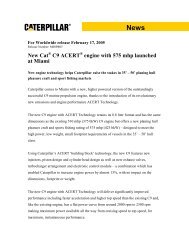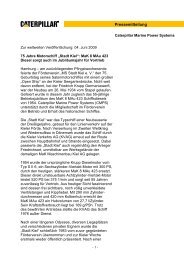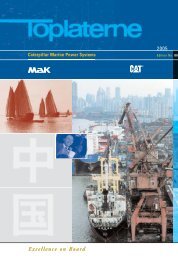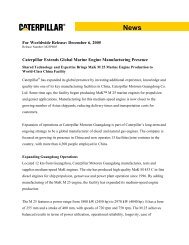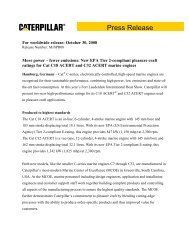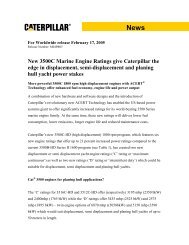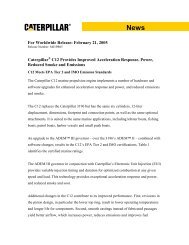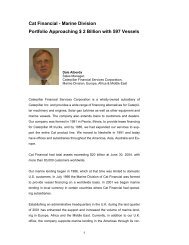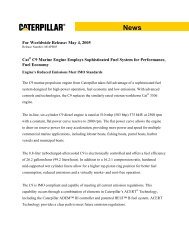Caterpillar Marine - Marine Engines Caterpillar
Caterpillar Marine - Marine Engines Caterpillar
Caterpillar Marine - Marine Engines Caterpillar
You also want an ePaper? Increase the reach of your titles
YUMPU automatically turns print PDFs into web optimized ePapers that Google loves.
<strong>Marine</strong> Engineering at Carnival<br />
Corporate Shipbuilding in<br />
Southampton (UK), summarises<br />
his overall impression<br />
of the MaK 9 M 43 C. Mr Joly<br />
also emphasises the excellent<br />
support provided via<br />
<strong>Caterpillar</strong> <strong>Marine</strong> and the<br />
various specialist groups in<br />
the <strong>Caterpillar</strong> engine plants<br />
in Kiel and Rostock. “We’re<br />
delighted to experience this<br />
engine in deployment. We<br />
expect reliability in operation<br />
and low fuel consumption,”<br />
Joly adds. “We’re particularly<br />
pleased by the<br />
Flexible Camshaft Technology<br />
(FCT) and the fact that<br />
this ensures extremely low<br />
soot particle emissions even<br />
with minimum output –<br />
exactly reflecting Carnival’s<br />
focus on sustainable development<br />
and environmental<br />
protection.”<br />
“High engine performance<br />
and dedicated customer<br />
advisory service” is<br />
also the verdict of Jens<br />
Kohlmann, Senior Superintendent<br />
Machinery, and<br />
Detlef Stremlow, Superin-<br />
tendent Newbuildings Machinery at<br />
AIDA Cruises in Rostock (Germany).<br />
“The surface temperatures correspond<br />
to SOLAS, the sound levels are below<br />
the limit values, the engine vibrations<br />
are restricted to a minimum, and<br />
the plant complies with the low prescribed<br />
levels for fuel consumption,”<br />
says Stremlow, soberly reading off the<br />
entries in his check list. Kohlmann and<br />
Stremlow are also impressed by the<br />
easy accessibility to every area of the<br />
MaK 9 M 43 C for inspection purposes.<br />
“We’re delighted by the results for the<br />
acceptance test of the engines for the<br />
ship,” concludes Kohlmann, “but from<br />
the standpoint of an operator, we’re<br />
even happier about the performance<br />
that can be expected in daily operation<br />
on board.”<br />
Satisfied shipyard<br />
“The AIDA engine plant offers<br />
numerous technical improvements,”<br />
explains Jürgen Storz, head of the<br />
10<br />
Dedicated for the “AIDAdiva” – shipment of one MaK 9 M 43 C<br />
engine<br />
Mechanical Engineering Group at<br />
Meyer Werft, “particularly for reducing<br />
emissions and minimising vibrations<br />
and for engine automation.” In<br />
particular, very strict limit values<br />
for soot particles and NOx over the<br />
entire load area required an advanced<br />
engine design “and the selected FCT<br />
system of MaK offered a very good<br />
performance,” emphasises Heinz-Hermann<br />
Jungeblut from the Mechanical<br />
Engineering Group at Meyer Werft.<br />
Strict requirements as regards vibrations<br />
also necessitated careful inspection<br />
of the engine vibrations and their<br />
effects on the built-on equipment<br />
and also vibrations transferred to the<br />
engine substructure, thus considerably<br />
affecting passenger comfort. “The<br />
new resilient dampers have in any<br />
case demonstrated their effectiveness:<br />
all vibration measurements were<br />
well below the specified limits,” notes<br />
Jungeblut.<br />
“Special priority was given to the automation<br />
system required by the yard for<br />
the engine plant. <strong>Caterpillar</strong><br />
and Meyer Werft cooperated<br />
closely to develop this,”<br />
comments Storz. The system<br />
comprises a safety management<br />
system and an alarm/<br />
monitoring system with a<br />
bus connector to the controlling<br />
automation system<br />
of the ship. Its function and<br />
the interaction with the<br />
engines were fully tested<br />
on the test stand. The connecting<br />
cables are ready, a<br />
class approval of the entire<br />
systems being made possible<br />
for the plant acceptance<br />
tests. This is an important<br />
advantage for the<br />
yard, according to Storz:<br />
“This innovative approach<br />
creates confidence even<br />
from the test stand phase<br />
and saves us a great deal<br />
of time with the later<br />
putting into operation of<br />
the engines on board the<br />
vessel.”<br />
That is also confirmed by<br />
Aloys Meemann, who heads<br />
the project management at<br />
Meyer Werft and is responsible<br />
for the punctual delivery<br />
of all four AIDA ships: “We’re convinced<br />
that all parties involved have<br />
done everything required to provide<br />
the ship owner with an innovative<br />
yet uncomplicated and therefore<br />
reliable engine plant. We’re highly<br />
satisfied with the cooperation with<br />
<strong>Caterpillar</strong>.”<br />
One hardly needs to add anything<br />
to these statements from the<br />
experts, except perhaps a concluding<br />
comment from Leif Gross, Sales<br />
Director Global Cruise Projects at<br />
<strong>Caterpillar</strong> <strong>Marine</strong>: “The <strong>Caterpillar</strong><br />
team is extraordinarily proud that<br />
it is equipping the new AIDA cruise<br />
ships with the basis of a powerful yet<br />
cost-efficient and low-emission propulsion<br />
plant. We’re already looking<br />
forward to April 2007, when the “AID-<br />
Adiva” will be named in Hamburg –<br />
the people of this city are meanwhile<br />
known as enthusiastic fans of cruise<br />
ships, including those at the headquarters<br />
of <strong>Caterpillar</strong> <strong>Marine</strong> Power<br />
Systems.”



